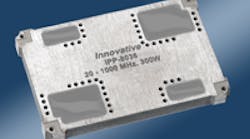Directional couplers are useful for sampling a portion of a signal for monitoring or testing, without effectively disturbing the main signal path. High-performance couplers do this with minimal signal loss in both the coupled and direct paths, and can be specified with a wide range of coupling values. Traditionally, surface-mount-technology (SMT) directional couplers have been somewhat limited in power-handling capability compared to coaxial units, mainly due to their small physical size and need to avoid high power densities in small-dimensioned transmission lines. But by applying practical thermal design techniques to their new model IPP-8036 SMT directional coupler, the engineers at Innovative Power Products have developed a 50-dB directional coupler (see figure) capable of handling 300 W RF power from 20 to 1000 MHz in a package measuring only 1.5 x 1.0 x 0.128 in.
In a directional coupler, higher coupling coefficients or coupling values generally allow lower theoretical insertion loss. The IPP-8036, with its 50-dB coupling coefficient and +/-1.5 dB coupling accuracy, has typically less than 0.35 dB insertion loss across its full frequency range. It is well matched to a 50-Ω environment, as evidenced by its low VSWR of better than 1.25:1.
Directivity in a coupler is essentially the difference in power level (in dB) at the coupled port for power sent through the coupler in the normal direction (from input port to main-line output port) versus the power level at the coupled port for power channeled through the coupler in the reverse direction (from main-line output port to input port). Directivity is assumed to be determined with reflectionless terminations at all ports of the coupler. The IPP-8036 SMT directional coupler boasts directivity of at least 20 dB at all frequencies, even when handling power levels to 300 W.
The firm's surface-mount couplers are mounted on the top of a printed-circuit board (PCB) using plated-through holes (PTHs) in the PCB. This establishes reliable ground connections and forms thermal paths from the bottom of the coupler package to transfer heat away from the coupler. The company also manufactures two other 50-dB SMT directional couplers capable of handling 300 W powermodels IPP-8044 and IPP-8045with frequency ranges of 20 to 520 MHz and 30 to 520 MHz, respectively. Model IPP-8044 features worst-case coupling flatness of +/-0.6 dB while model IPP-8045 exhibits worst-case coupling flatness of +/-0.5 dB. Both couplers have maximum insertion loss of 0.25 dB, maximum VSWR of 1.25:1, directivity of 20 dB, and coupling flatness of +/-1 dB.
The compact IPP-8036 directional coupler features coupling flatness of +/-0.6 dB across the full frequency range. The coupler is designed to be used at operating frequencies from -55 to +85C. It is available in tape-and-reel format for use with automated assembly stations. Innovative Power Products also supplies drop-in style and connectorized directional couplers, currently at frequencies through 6 GHz and at CW power levels to 1 kW (at 3 GHz). P&A: stock to 4 weeks.
Innovative Power Products
1170 Lincoln Ave.
Holbrook, NY 11741
(631) 563-0088

